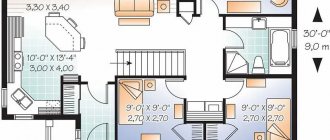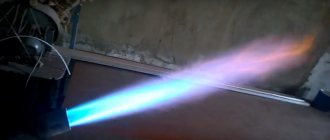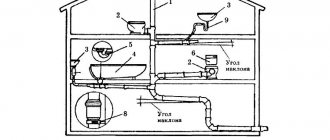The installation of gas communications in an apartment is subject to certain requirements, therefore, independent installation and connection of equipment, as well as moving the gas pipe to another place, is strictly prohibited.
All issues regarding the laying of internal and external gas pipelines are resolved by the gas service, without whose permission it is only possible to move the stove a limited distance.
We will tell you how to obtain approval for replacing a gas pipeline, and also describe the technology for moving an intra-apartment pipeline. The proposed instructions are not a guide to action; all work must be carried out by a representative of the gas service.
Standards and rules for placing gas pipes in an apartment
The transfer of a gas pipe is possible only with permission from the gas industry.
The rules for installing a gas main in housing are prescribed in the text of SNiP 2.04.08 - 1987.
Principles for locating pipeline sections:
- decoration on walls made of flammable materials is protected by plaster or metal panels;
- the shut-off valve cannot be removed from the pipe; it is located in an accessible place;
- the gas pipeline is painted in a contrasting color with the wall with waterproof compounds;
- laying in the thickness of walls and horizontal ceilings is done using a case with a shock-absorbing insert.
Devices and installations are connected to the gas pipeline with rigid fastenings. A technical specialist gives an opinion on the possibility of altering the gas distribution.
No. 3. Let's use a trick, or Railing to the rescue
Let us note right away that you cannot hang anything on a gas pipe, but you can create the illusion that it is not a pipe that has set your teeth on edge, but a completely necessary railing designed for the project. Hooks, various shelves and holders are usually attached to the railing. Since it is based on horizontal guides, this method is perfect for masking horizontal sections of pipes.
The essence of the method is to paint the gas pipe in a color that best matches the color of the selected roof rail. The latter are often chrome plated, made to look like bronze or copper.
The railing is mounted just below the gas pipe. All objects are hung on the railing pipe, but due to the proximity of the location and similarity of the surface, the gas pipe will look like part of the overall system. The solution is perfect for interiors designed in a modern style.
Reasons for moving gas pipes
The reason for moving pipes may be their emergency condition.
The official program of government agencies allows for major repairs and replacement of gas main risers in old apartment buildings free of charge.
Reasons for work:
- gas emission was detected when the tap was closed (repairs are being done in the apartment);
- damage to pipes and welds is visually distinguishable;
- The service life has expired (for houses built more than 50 years ago).
Utility workers report a planned replacement of the supply pipeline, and the organization is developing a work schedule. Residents are given access to equipment within designated periods.
Repairs must not be prevented, because masters work with gas pipelines that are in common use and are on the balance sheet of the utility organization.
Redevelopment
Replacing pipes may be associated with the purchase of new furniture for the kitchen.
A frequent reason for altering the gas distribution in an apartment is the purchase of a kitchen unit that has a built-in heated panel or oven. For installation, it is necessary to shorten or lengthen sections of pipes in order to supply gas to the installation site.
It is recommended to contact a licensed design firm to draw up a plan for redevelopment, movement of equipment and laying a gas pipeline from the common input. In apartments, it is prohibited to move risers, slabs, and pipelines into rooms. Coordination is also necessary to combine the living room and kitchen.
Major renovation
Before starting repairs, housing and communal services inform residents about the inspection and the start of repairs. Carrying out dismantling and installation work causes discomfort for residents of the apartment. Residents are concerned that experts may damage furniture or finishes and are trying to negotiate additional agreements with contractors.
The organization invited to redo the gas pipeline is not required to draw up an agreement with the owners of each apartment. Owners provide access to the replacement site as part of the utility equipment replacement program. Residents do not have the right to refuse, so as not to provoke further emergency situations. In the absence of cooperation, the gas workers turn off the common tap on the riser.
Alteration of gas wiring
Flexible gas pipes cannot be carried by yourself.
Sometimes a gas pipe runs where kitchen cabinets are hung. The owners cut the back walls, make holes in the furniture, and move the cabinet away from the wall using spacer bars. Such actions entail a reduction in kitchen space. Specialists can weld the line at a different height from the floor so that furniture installation takes place without obstacles.
The area where the sink is installed may coincide with the installation location of the gas pipeline. Technical specifications (TU) do not allow laying a gas pipe under the sink, so the gas pipeline rises above the cabinets, and a vertical section is made above the stove.
SNIP, project formation, final documentation
*
For apartment buildings there are strict standards for installing gas equipment:
- gas pipeline systems should not intersect with door, window openings, ventilation lines and shafts;
- pipes are laid at a height of no lower than 2 m from the field level;
- ceiling height in rooms with gas equipment is more than 2.2 m;
- the length of flexible pipeline sections is limited;
- the distance between gas and electrical equipment of any type is regulated by the rules for installing electrical equipment;
- access not only to individual components, but to the entire system must be free for repair and maintenance work;
- between the room with gas-powered appliances and other rooms there must be a barrier in the form of a door or any partition;
- the room has a window with a ventilator or ventilation mode, operating supply and exhaust ventilation;
- the type of pipe fastening (hook, bracket, clamp, hanger) and the distance between the fastening points is determined by SNIP.
Kitchen project diagram
Pay attention! If the system is installed under liquefied gas, a slope of 3 degrees is provided.
The design organization begins work if a package of documents is provided. It's forming
- from a notarized copy of the technical passport for the apartment;
- an expert opinion, documented in an act, on a chimney pipe made of gas;
- permission to connect from the architectural and planning organization; all technical documentation for gas appliances (certificates of conformity, technical data sheets).
But you can not collect documents yourself, but from the very beginning provide the opportunity for a special bureau to do this. Then the customer receives a finished project with all approvals, as well as estimates and costs. Additionally, it is necessary to draw up an agreement for technical supervision.
After receiving the project, installation work is carried out. The last stage of commissioning a new gas pipeline consists of the following steps:
- Compile a package of executive and technical documentation.
- Conduct an inspection of the correctness and quality of the work performed by a commission consisting of the customer, the contractor, and representatives of the city gas company.
- Seal the gas meter.
Gorgaz representatives have the right to constantly monitor the operation of gas equipment.
Sealing of the meter by a representative of Gorgaz
Preparatory stage
The flexible hose should also not be changed independently. Extending the length, cutting and moving the gas pipe in the kitchen is carried out by the organization. The owner of the property should also know the sequence and other features of the work in order to prevent illegal actions.
Usually 2 people work, who begin the rearrangement a week after the project is completed and approval is received. By the time work begins, there is already information about the areas that will be converted. There is a diagram of the new location of additional gas appliances, for example, a heating column.
General gas supply requirements
Correct connection of the gas hose
Pipes can only be installed horizontally or vertically; rotation is allowed at 90°. Laying diagonally or in a curved arc is not permitted.
Rules for running the supply line:
- internal wiring is carried out in an open way, decorative elements are made removable and with identification markings;
- It is prohibited to carry it through ventilation risers, window and door openings;
- rigid elements are used, the length of flexible hoses for connecting the plates cannot exceed 3 m;
- Pipes are connected by welding; detachable contacts between two sections are prohibited.
Work begins with shutting off the valve on a house or a certain area. The service provider is responsible for interfering with the gas supply.
Getting permission
Errors when moving pipes can lead to a gas explosion.
Illegal redevelopment or connection of slabs or water pumps will result in general administrative and criminal penalties, depending on the situation. The minimum fine is 2 thousand rubles, and if due to arbitrariness an accident occurs or people are injured, the culprit faces up to 5 years in prison.
The owner offers his own option for rearranging the pipe, and the technicians of their utility service allow or not the specified redevelopment. To call a specialist, the owner contacts the office at the place of registration. Sometimes it is necessary to involve additional companies, which will be reported by management employees.
Video description
How to hide pipes on a kitchen apron in the following video:
Plasterboard box
A metal frame box lined with plasterboard sheets is a good idea as long as it allows air circulation and access to the riser. The first is possible if you use sheets with perforations, the second - if you provide a removable panel or a hinged door.
The easiest way to organize the box is in the corner; The option will be budget-friendly, since two walls will be enough. Experts advise making a decorative box for a gas pipe from sheets of fire-resistant plasterboard (GKLO). Drywall can be replaced with plastic, plywood, fiberboard or chipboard.
Box with additional function Source folksland.ne
Work order
If an oven or stove is connected, the owner purchases a bellows sleeve at his own expense. Craftsmen bring metal pipes with them, because... their cost is already in the contract estimate. The kitchen is cleared of unnecessary furniture and utensils to avoid delays in work.
The owner has the right to demand the provision of certificates from the gas organization. The workers' qualification certificates are checked and only after that they can begin re-equipping the gas pipeline.
Tools and materials
Copper pipes for gas pipelines
Cutting and welding sections of the gas pipeline is carried out using special devices, units and tools that the craftsmen bring with them. The work is carried out in accordance with safety requirements.
The following types of collectors are used for the gas main:
- copper;
- steel;
- polypropylene.
The materials are durable and have the required properties, ensure tightness and prevent leakage. Steel pipes are taken of the low-carbon variety St2, St4, which can withstand excess pressure. During major re-equipment, shut-off valves made of gray cast iron, steel, bronze and brass are used.
Dismantling an old pipe
The line in the working area is purged after closing the general valve on the supply pipe in order to remove remaining gas from the collector. When transferring, you need to cut off a piece of pipeline and weld a new section in the required direction. To remove an unnecessary section, the master uses welding, a pipe cutter or a grinder. Previously, a metal file was used, but in modern conditions it is time-consuming and ineffective.
An area is left where the shut-off valves at the entrance to the apartment are located. This section cannot be dismantled; the gas valve can be moved if the line in this place is severely damaged.
Change options
Gas pipes cannot be recessed into the wall - they must be constantly accessible.
The area around the pipes must be open so that residents know about the leak in time and take action. It is prohibited to recess pipes into the wall and seal them tightly with plaster or other materials.
Placed to fix the pipe:
- crimp clamps;
- hooks;
- mounting brackets;
- pins or pendants.
If electrical wiring runs nearby, it should be no closer than 25 centimeters. The electrical distribution panel is placed no closer than 0.5 meters from the gas pipeline. For the liquefied gas main, a slope of 3° from the entrance is provided. If there is a meter, the slope is calculated from this place.
Work process
Welding is used to connect pipe sections.
Rubber hoses or rubber-fabric products are used less frequently, because Bellows adapters are gaining popularity.
The following actions are performed:
- The hole is welded after trimming the area.
- At the point where the new section is connected, a hole is drilled in the pipeline using a power tool and a drill with a metal tip.
- A piece of pipe is attached by welding, and a tap is mounted at the end if necessary.
When connecting the tap, tow or sealant is used, and sealing tape is applied. After this, connection is made to the gas appliance with a flexible hose. Check for gas leaks using a soap solution.
Replacing the gas riser
During the procedure, there should be no strangers or smokers in the workplace. Before starting the replacement, the specialist will post a warning sign about the dangerous nature of the work. Simultaneous replacement of the riser and installation of wiring in the apartment is not allowed, because A spark can cause an explosion.
The type of riser welding is selected depending on the thickness of the main wall. More often, steel elements with a diameter of 21.3 - 42.3 mm, with a wall thickness of 4 mm, which are connected by gas or electric welding, are used for feeding.
Features of transfer in the kitchen
Gas pipes are located so that after installation there is the possibility of their repair, preventive inspection or replacement. The insertion into the pipe is carried out so that during chemical analysis the presence of oxygen in the gas mixture is no more than 1%.
Gas should come out of the pipeline evenly, without jerks, jolts or pops. The check is carried out by purging the system, and you need to make sure that during the process the gas does not enter the atmosphere of the room, ventilation shaft or chimney. Before the first start, window openings are opened to ensure effective ventilation of the kitchen.
Selection rules
Gas valves made in Italy are leaders in the sales market.
Before changing the gas valve, you should familiarize yourself with the main criteria that characterize the quality and reliability of the products.
- Life time. Considering the specifics of replacing a gas tap, it should be done as rarely as possible. Based on this, the minimum period is 10 years.
- Manufacturer. Preference should be given to trusted brands and dealers. It is not recommended to purchase products from China. The best choice would be products from Italy, Germany, Poland and France.
- Type of marking. All characters must be clear, without spaces, bends or sagging. Plus, complete information about the brand, size, pressure, material and standard.
- Quality. The internal element must completely cover the gap and have perfect polishing without mechanical damage. A magnet checks for the presence of iron in the product.
When purchasing, you should ask the seller for a certificate to make sure that the product is not a fake.
Checking the entire system for leaks and operability
Leaks are checked using a soap solution.
The test is done after installation is completed, leaks and operability are diagnosed. First, the general appearance of the system is inspected, the connections are checked, the fittings are tightened, and compliance with the design diagram is checked. Gas emissions are detected at connections and assemblies.
A soap solution is used to coat the joints of pipes with a hose, the interface between a flexible hose and a stove or oven. If bubbles form, the node requires revision and re-diagnosis. The master draws up a report of completed work describing the features, changes are entered into the technical passport.
The law is harsh...
Household gas is a source of increased danger, or rather an explosion hazard. Moreover, not only you and your home can suffer, but also your neighbors and the whole house. Therefore, everything related to gas is subject to strict regulation. For violating the rules there is a very serious fine.
SNiP 42-01-2002 specifies the technical requirements for the operation of the gas pipeline. What is important for us here:
- all gas equipment, including pipes, must be open and accessible for inspection;
- it is not allowed to close the pipeline hermetically;
- various structures covering the gas pipeline must be easily removable and not impede air circulation. There should be no load on the pipe, i.e. You can't attach anything to it.
Coordination of work on moving a gas pipe
The owner contacts the gas service employees, explains the situation and receives advice. The application is drawn up and submitted in person when visiting the organization’s office. Based on this document, the company sends a specialist to discuss the details.
The specialist examines the system, correlates the client’s wishes with the actual situation, and answers questions.
Sometimes the customer’s plans are violated because his wishes go against safety regulations.
The organization draws up an estimate for the work and a plan for re-equipping the gas pipeline in the kitchen. The customer pays for the service, and the company approves the start of work.
About the minimum required distances
When considering the question at what distance from the gas pipe you can build a house, it is recommended to remember some subtleties. If for overhead communications it is enough to create a two-meter security zone, then the distances for underground pipelines are dictated by two parameters: the pressure under which the gas is supplied and the diameter of the pipe.
Minimum distances maintain operational safety Source gazmaster78.ru
The greater the pressure in the system, the higher the possible danger to the owner’s home. Therefore, the distance from the gas pipe to the building according to the standards is determined, first of all, by the type of gas pipeline:
- There must be at least 2 m between the foundation of a residential building and the low-pressure main (running along the facade).
- A distance of at least 4 m is maintained to the medium pressure main.
- To the high pressure line: at least 7 m.
The burial depth does not exceed 0.6-0.8 m. The footage from the fence to the buried pipe is not regulated in any way, but the fence should not fall into the security zone. There are restrictions on installation on facade walls: at least 50 cm from the doors and 20 cm from the roof or window.
Gasification of a private home in compliance with the rules Source szgaz.ru











